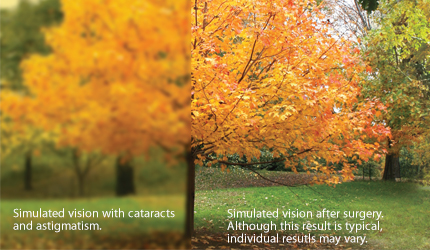About The Toric Single Focus Lens Implant

Toric lens implants are one of the most popular technologies for cataract patients with astigmatism who do not intend to wear eyeglasses at all times. They are designed to improve how well you see without eyeglasses in the distance, as compared to if you had a standard lens implant.
What is astigmatism?
Like nearsightedness, astigmatism describes a common type of natural blur in healthy eyes that is corrected by wearing eyeglasses. It results from an inherited, imperfect optical shape of the cornea, the clear front window of the eye. The shape of your cornea should be perfectly round, but if is more oblong (like the back of a spoon) instead of spherical, then it will misfocus details causing your natural vision to be blurrier compared to patients without astigmatism. The more astigmatism one has, the blurrier the vision is without eyeglasses and there is no advantage to astigmatism because it adds natural blur to every focal distance. Corrective eyeglasses compensate for this corneal shape to optically correct this blur and to properly focus eyes with astigmatism.
Although it has nothing to do with cataracts, astigmatism can be reduced or nearly eliminated at the same time that cataract surgery is done. By mapping your corneal shape with a diagnostic technology called corneal topography, we can calculate the amount of astigmatism correction that your eye should require in eyeglasses following cataract surgery. We can then incorporate this amount of astigmatism correction into the artificial lens that is selected for your cataract surgery. This is called a toric lens implant and it represents a more customized permanent lens implant for your eye.
The toric lens may not correct all of the astigmatism, especially if it is severe. Weaker eyeglasses can correct whatever astigmatism remains. In addition, like the conventional lens implant, the toric lens is still a “single focus” lens and therefore reading glasses must still be used if the distance eyesight is good. However, toric lens implants allow appropriate patients to see better whenever they are not wearing eyeglasses, and any eyeglasses worn will be less strong as a result. For example, over-the-counter reading glasses or non-prescription sunglasses should work much better if your astigmatism is minimized. Finally, compared to the conventional lens implant, the toric lens does improve the “depth of focus” for patients with astigmatism. Although it can increase slightly in some eyes with age, astigmatism won’t go away on its own, and therefore the benefit of the toric lens implant should be life-long.
Will I still need eyeglasses with a toric lens implant?
The toric lens implant does NOT allow you to both read and see far away without eyeglasses. It may not necessarily correct 100% of your astigmatism either. However, compared to a conventional lens implant that does not correct astigmatism, the toric lens implant should improve how well you see without glasses, and any eyeglasses that you do require should be less strong and potentially more comfortable to wear.
Like contact lenses or eyeglasses, every artificial lens implant model (both standard and toric) is manufactured in more than 60 different “powers”. As with prescription eyeglasses or contact lenses, it is important to match the appropriate artificial lens implant power to your eye. To prescribe the correct spectacle or contact lens power, we utilize trial and error to preview various lens powers in front of your eye. When you are asked, “which is better, one or two?” during an eye exam, you are selecting the lens power that you see best with. However, because the artificial lens implant is only inserted inside the eye after your natural lens (cataract) has been removed, it is impossible for you to preview or “try out” different powers during the middle of surgery. In the operating room, we obviously cannot insert more than one lens implant to let you select which one gives you the best distance focus. Nor can we switch to a different lens implant power later on as one could with contact lenses.
Fortunately, the appropriate power of the lens implant can be estimated using mathematical formulas that utilize preoperative measurements of your eye’s dimensions. Although the measurements are very accurate, there are individual variables that prevent this process from being 100% perfect. One variable is the final precise position where the implant will end up inside your eye after healing is complete. The entire process is accurate enough so that most patients will see quite well without glasses in the distance (assuming that was the target). However, it frequently won’t be “perfect” and you might choose to wear thin glasses with a mild prescription for those times when a sharper distance focus is required.
What are the risks or disadvantages to toric lens implants?
Toric lens implants pose no additional medical risk and are perfectly safe. Because they are still a single-focus lens, they do not introduce halos or other additional optical side effects. They do not require the cataract surgery to be performed any differently and do not effectively lengthen the surgical time. Although the surgical recovery is no different, patients with astigmatism do see better with toric lens implants during the early postoperative period when they have not yet received new prescription eyeglasses.
Toric lenses do involve additional costs, however. Health insurance, such as Medicare and PPOs, covers the costs of cataract surgery with a standard lens implant. However, the additional charge for implanting toric lenses is not covered, and must be paid out-of-pocket by the patient. Remember that the benefits of toric lens implants are to improve your natural vision without eyeglasses. They are not “medically necessary” because they have nothing to do with improving your eye health.

